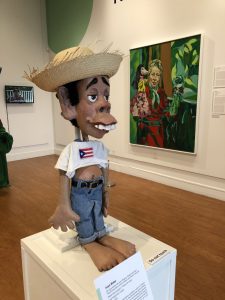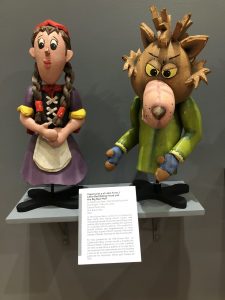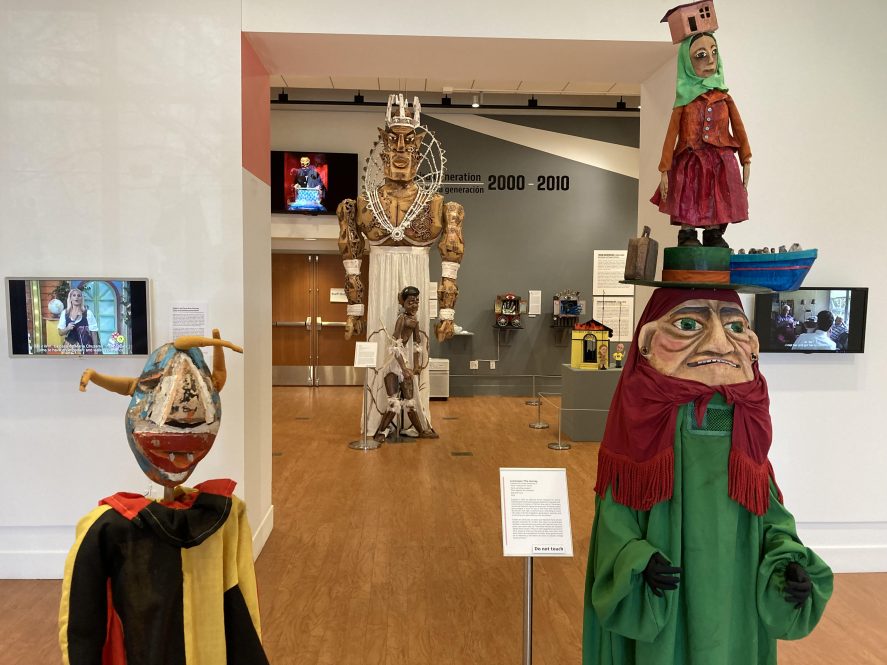The beloved character Juan Bobo, with his distinctive straw hat and white T-shirt with the Puerto Rican flag, greets visitors at the entrance of the Ballard Institute and Museum of Puppetry, welcoming them to the world’s first puppetry display dedicated to the Caribbean island.
While this Juan Bobo is only a few feet tall, over his left shoulder is a larger-than-life processional costume depicting an older woman who’s traveling with a young girl, and over his right, a pair of menacing vejigante puppets look on. Together they’re part of “Hecho en Puerto Rico: Four Generations of Puerto Rican Puppetry,” an exhibit meant to celebrate Puerto Rico’s rich culture and its use of puppets to educate, entertain, and advocate.
“We’re always trying to connect with the very large Puerto Rican community in Willimantic and the huge Puerto Rican community in Hartford through festivals and various events, so when the idea for a full exhibit of Puerto Rican puppetry came about we knew immediately it was something we wanted to do,” Museum Director John Bell says.

Puppeteers Manuel Moran and Deborah Hunt curated the display that opened in November and closes in June based on Moran’s 2016 documentary film “Titeres en el Caribe hispano,” a four-part series that explores the use of puppetry not just in Puerto Rico, but also Cuba and the Dominican Republic.
For the Ballard exhibit, Moran and Hunt grouped puppets into four categories dating to 1960 with “The Pioneers” and extending to present day with “Emerging Artists.” Bell says that offering the exhibit in English and Spanish was simply a logical decision.
The collection depicts not just the expected Afro-Caribbean culture of the island, but also the indigenous Taino influence, the territory’s relationship with the United States, and the detest for colonialism that goes back to the time of the New World, Bell says. Puppets in the collection highlight issues of debt and ecology, as well as critiques of the educational system and even fast-food diets.

“Puppetry has had a racial reckoning with its Black minstrel shows and Asian characters, and addressing that is essential,” Bell says. “Puppetry is sometimes considered a marginal art form. We want to draw attention to what puppetry has been, is, and could be and how it connects with the important ideas that people have about themselves, their communities, and their society.”
Visitors will find on display a puppet of Titi Gandinga, a YouTube and Facebook character who is “a funny old lady who loves to judge others and gossip about everyone”; the marionette Pancho, which has been used around Puerto Rico in school and church shows; and a backpack puppet from the group Poncili Creacion’s parade in Puerto Rico, called “Somxs Podemxs/We Are We Can,” that dramatically takes note of various social issues, including the Black Lives Matter movement, immigration, and transgender rights.
“This kind of consciousness about what’s going on in our world isn’t unique to Puerto Rican puppetry, but I do notice that it comes into the fore a lot in the exhibit,” Bell says.
He adds, “We’re hoping people will come and say, ‘Wow, I never knew about this type of puppetry from Puerto Rico and that there’s so many different ways that puppets can do so many different things. They can educate, they can make you laugh, they can tell a tragic story, they can talk about the history of water, they can talk about colonialism, they can address all these different things. They can be part of a Shakespeare play in a Caribbean context. This show illustrates all of those possibilities.”
“Hecho en Puerto Rico: Four Generations of Puerto Rican Puppetry” runs through June 11 and is co-sponsored by UConn’s Puerto Rican and Latin American Cultural Center and El Instituto: Institute of Latina/o, Caribbean, and Latin American Studies.
The Ballard is open Wednesday through Saturday, 10 a.m. to 4 p.m., and visits are by reservation only. To make an appointment online go to bimp.uconn.edu/visit/reservations.



